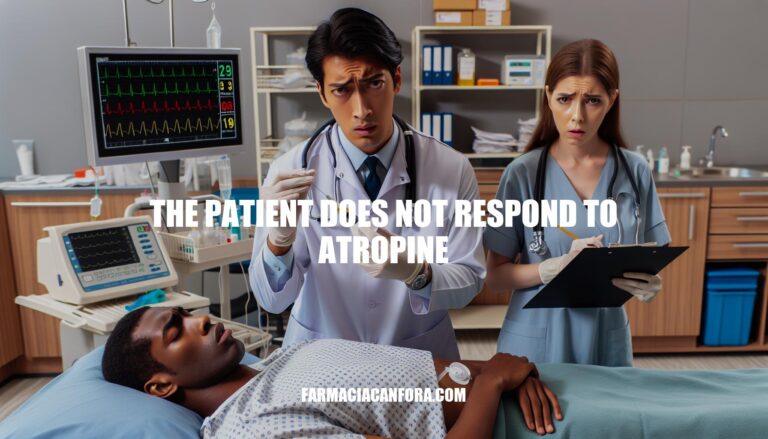In emergency medicine, encountering a patient who does not respond to atropine during the management of severe bradycardia can be challenging. Atropine is typically the first-line treatment for this condition, but when it fails, it indicates a more complex underlying issue that requires immediate and alternative interventions. Understanding this scenario is crucial for healthcare providers to ensure timely and effective treatment, potentially involving second-line drugs or advanced pacing techniques.
Causes
When a patient does not respond to atropine, several potential causes and underlying conditions might be at play:
-
Severe Bradycardia or Heart Block: In cases of severe bradycardia or advanced heart block, atropine may not be effective due to the extent of the underlying cardiac condition.
-
Drug Interactions: Certain medications, such as beta-blockers or calcium channel blockers, can counteract the effects of atropine.
-
Organophosphate Poisoning: In cases of organophosphate poisoning, the required dose of atropine might be significantly higher, and initial doses may appear ineffective.
-
Autonomic Neuropathy: Conditions like diabetes can lead to autonomic neuropathy, which might reduce the effectiveness of atropine.
-
Hypothermia: Atropine’s effectiveness can be reduced in hypothermic patients due to slowed metabolism and drug absorption.
-
Severe Hypoxia or Acidosis: These conditions can impair the drug’s action at the receptor level.
-
Genetic Variations: Some individuals may have genetic variations that affect their response to atropine.
These factors can contribute to a situation where atropine does not produce the expected therapeutic effect.
Diagnosis
When a patient does not respond to atropine, follow these diagnostic steps and considerations:
-
Assess Clinical Condition:
- Check for symptoms like hypotension, altered mental status, signs of shock, ischemic chest discomfort, or acute heart failure.
-
Monitor and Evaluate:
- Maintain a patent airway and assist breathing if necessary.
- Administer oxygen if the patient is short of breath.
- Use a cardiac monitor to identify rhythm and monitor blood pressure and oxygen saturation.
-
Consider Alternative Treatments:
- Transcutaneous Pacing (TCP): Initiate TCP in unstable patients who do not respond to atropine.
- Medications: Consider dopamine or epinephrine infusions if TCP is not immediately available.
-
Identify and Treat Underlying Causes:
- High-Degree AV Block: Immediate pacing is recommended for patients with high-degree AV block.
- Distal His-Purkinje Block: This condition tends not to respond to atropine and may require more aggressive pacing measures.
-
Differential Diagnoses:
- Vagally-Mediated Bradyarrhythmia: Elevated vagal tone due to respiratory, gastrointestinal, ocular, or neurologic disorders.
- Sinus Node Dysfunction: Often treated with watchful waiting, atropine, or sympathetic medications.
- AV Nodal Dysfunction: May require pacing if severe.
These steps ensure a comprehensive approach to managing patients unresponsive to atropine, addressing both immediate and underlying issues.
Alternative Treatments
When a patient does not respond to atropine, consider the following alternative treatment options and protocols:
- Transcutaneous Pacing: Initiate transcutaneous pacing to stabilize the heart rate.
- Epinephrine Infusion: Administer an epinephrine infusion at 2-10 mcg per minute.
- Dopamine Infusion: Administer a dopamine infusion at 5-20 mcg/kg per minute.
- Expert Consultation: Seek expert consultation for further management.
These steps can help manage bradycardia when atropine is ineffective.
Case Studies
Here are some case studies where patients did not respond to atropine, along with different approaches and outcomes:
- Myopia Progression in Children:
- Case: An 11-year-old boy with rapidly progressing myopia did not respond to 0.025% low-dose atropine.
- Approach: Increased concentration of atropine, referral to an ophthalmologist, and consideration of alternative treatments like orthokeratology or multifocal contact lenses.
- Outcome: Continued monitoring and adjustment of treatment strategies based on the patient’s response.
- Bradycardia Treatment:
- Case: A patient with bradycardia did not respond to atropine.
- Approach: Administered epinephrine and dopamine as chronotropic drugs, and started transcutaneous pacing.
- Outcome: Stabilization of heart rate and improvement in the patient’s condition.
- Bradycardic Periarrest:
- Case: Outpatients with bradycardia did not respond to atropine but responded well to isoproterenol.
- Approach: Switched to isoproterenol, a beta-agonist with a similar mechanism of action to epinephrine.
- Outcome: Effective management of bradycardia in patients who did not respond to atropine.
Managing Severe Bradycardia: Alternative Interventions
When a patient with severe bradycardia does not respond to atropine, it indicates a more complex underlying issue that requires immediate and alternative interventions.
Healthcare providers must understand the potential causes and underlying conditions, such as:
- Severe bradycardia or heart block
- Drug interactions
- Organophosphate poisoning
- Autonomic neuropathy
- Hypothermia
- Severe hypoxia or acidosis
- Genetic variations
To manage this situation, healthcare providers should:
- Assess the patient’s clinical condition
- Monitor and evaluate their response to treatment
- Consider alternative treatments such as transcutaneous pacing (TCP) and medications like dopamine or epinephrine infusions
- Identify and treat underlying causes
- Perform differential diagnoses
Alternative treatment options include:
- Initiating TCP
- Administering epinephrine or dopamine infusions
- Seeking expert consultation
Recognizing and managing situations where the patient does not respond to atropine is crucial for timely and effective treatment.


